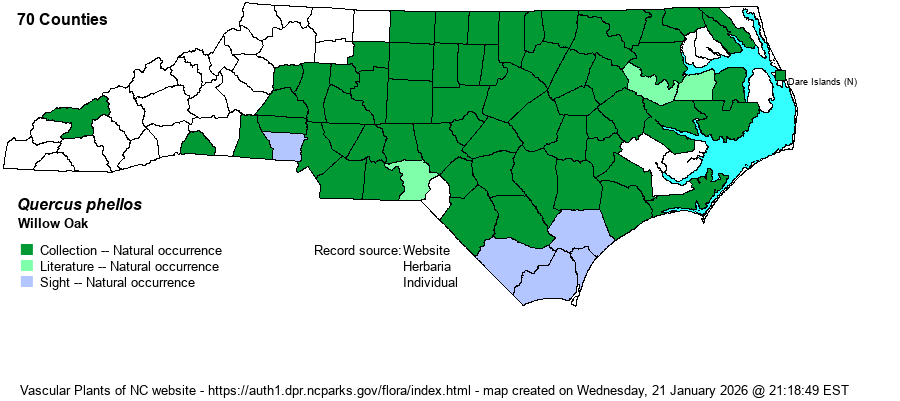| Author | L. | |
| Distribution | Essentially throughout the Coastal Plain and Piedmont; however, scarce in the far eastern counties, and also scarce to absent in Piedmont counties bordering the Blue Ridge Escarpment. Present in Swain County in the southern Mountains.
This is a widespread Southeastern species, occurring from Long Island (NY) and southeastern MO, south to northern FL and eastern TX. It is scarce to absent from most of the Appalachians.
| |
| Abundance | Common and widespread in most of the Coastal Plain and Piedmont; infrequent in part of the far eastern counties, though likely present in all of these counties. Absent to very rare in the Piedmont foothills and the southwestern Mountains. | |
| Habitat | This is another oak that is found primarily in floodplain forests, mainly in brownwater bottomlands and levees. It can occur in blackwater situations, though the similar Laurel Oak (Q. laurifolia) usually replaces Willow Oak there. The species also occurs at floodplain pools, upland depression swamps, and also can be found in upland forests, mainly over high pH soil. In uplands, it can even occur in glades and hardpans -– in shallow soils -– but usually only over circumneutral soil. In recent decades it seems to be increasing as an understory species in mesic uplands. |
| Phenology | Flowers from March to May, and flowers from September to November of the second year. | |
| Identification | This very familiar (often as a street tree!) deciduous tree grows to medium to rather large size, often 90-100 feet tall. When in leaf, it can normally only be confused with Laurel Oak or Darlington Oak (Q. hemispherica), though inexperienced people might confuse the leaves with willows. The leaves are very narrowly elliptic and glossy above, being about 3 inches long but only about 2/3-inch wide (about 5-8 times longer than wide); the margins are entire but there is a small bristle tip. Though the leaves are glossy above, they turn brown by mid-to late fall; leaves of the other oaks tend to be broader (less than 5 times as long as wide), and by mid- and late fall are still green and remain on the trees. See Weakley (2018) for other leaf characters for these three species. | |
| Taxonomic Comments | None
| |
| Other Common Name(s) | None | |
| State Rank | S5 | |
| Global Rank | G5 | |
| State Status | | |
| US Status | | |
| USACE-agcp | FACW link |
| USACE-emp | FAC link |

